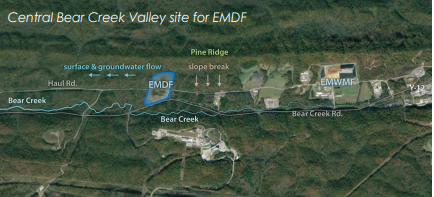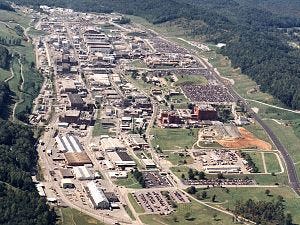Manhattan Project radiation lingers in Oak Ridge. Critics want more info on a new landfill
Since 2012, the Department of Energy has been batting around proposals to build a landfill for scraps of demolished buildings from Y-12, the site that contains low-level radiation from Manhattan Project work that took place there.
Federal officials have selected a forested area in the Oak Ridge Reserve, not far from Y-12, at the headwaters of Bear Creek, which flows into the Clinch River. Tennessee environmental regulators have been reviewing plans and submitting comments for over a decade.
Local environmental groups, while acknowledging the decades-old waste has to go somewhere, say it isn't clear in the 100-page proposal how the new landfill will protect people and the environment from radiation leaks.
"If you're just moving the contamination from the buildings into the river, you might be getting it off the DOE's property but you're not actually picking it up," said Amanda Garcia of the Southern Environmental Law Center. "You're distributing it more broadly into the community."
Environmentalists who spoke with Knox News don't oppose landfills outright, but they are critical that specifics of this plan are hard to find.
More: National Nuclear Security Administration ends Y-12 contract and will start over with search

The Department of Energy’s Office of Environmental Management is holding a public meeting in Oak Ridge to receive public comment on its plans to construct a 92-acre radioactive waste landfill in Bear Creek Valley. The meeting is from 6-8 p.m. Tuesday at the Pollard Technology Conference Center, 210 Badger Ave. in Oak Ridge.
“DOE is opening a 30-day public comment period and hosting a public meeting to provide details and answer questions from the community related to the subject areas covered in the fact sheets,” DOE spokesperson Ben Williams write in an email to Knox News.
The new effort is in addition to a 120-day public comment period that took place in 2018.
Environmental watchdogs, retired Tennessee Department of Environmental Conservation workers and Oak Ridge residents say the landfill fact sheets don't address issues that have persisted since the project was first proposed around 2011.
Turning waste into shoes and clothing: Oak Ridge National Lab turns pollution into fuel, plastics and ... high-end clothes?
Coming soon: US nuclear fuel manufacturer will open $13 million production facility in Oak Ridge
They're worried water will flood the landfill site someday, which could then spill out and carry contaminants downriver. East Tennessee is rainy — and getting rainier — and the landfill site is in a steep ridge valley at the headwaters of a creek.
"They are stonewalling us," said Axel Ringe, conservation chair of the Tennessee Chapter of the Sierra Club. "We have been asking consistently for more information that is needed to make knowledgeable comments and they simply don't do that."
Ringe said the Department of Energy has failed to provide data about the way groundwater moves through the proposed landfill site, the kind and volume of waste that will be disposed of, and whether the landfill could hurt Bear Creek, which is easily accessible from a popular hiking trail.
The DOE did not respond to Knox News' questions about the concerns of the community. In public comments, though, the DOE said it flatly disagreed with criticism that an existing landfill was mismanaged. They also disagreed that the location of the new landfill had been inadequately studied.
"There are hundreds of wells in Bear Creek Valley with decades of data," the DOE wrote. "The design, as it progresses, will be modified as needed to consider new data."
How we got here

The new landfill is intended to expand low-level radioactive waste disposal capacity as part of the decades-long cleanup of legacy nuclear facilities from the Manhattan Project and Cold War. The DOE currently uses another landfill, the Environmental Management Waste Management Facility, to dispose of low-level radioactive waste. That site is 80% full and is located just west of Y-12.
"They talk about how for 20 years it's operated with no problems," said Ringe. "That's not true. The (landfill) has had a long series of overflow events that basically dumped untreated effluent into Bear Creek."
A team of civil engineers based at the University of Virginia found that leachate, which is water that passes through the current landfill, had on average more than double allowed concentration of uranium in drinking water. This leachate is treated by the DOE at a nearby facility.
But that treatment process can't happen if a landfill floods, critics say.
A long process
Discussions about a new landfill have been ongoing between the Department of Energy, the Environmental Protection Agency and the Tennessee Department of Environment and Conservation since roughly 2011. The three agencies have repeatedly come to impasses over the DOE’s plans, citing a lack of clarity and lack of data. These disputes have frequently reached officials in Washington, D.C.
"We have to remember that the goal, the standard that EPA and TDEC have to determine, is whether the (landfill) is protective of human health and the environment," Garcia said. "You're leaving big gaping holes in the information that's available to EPA and TDEC, let alone the public."
The latest drafts of the proposed landfill plans continue to dog EPA and TDEC with clarity and regulatory issues. Specifically, whether the DOE's plans comply with the Clean Water Act and Tennessee state antidegradation rules.
Garcia said the updated fact sheets available to the public did not address these ongoing concerns. She said that if this landfill is going to be protective, the department needs to established ahead of time the type and volume of waste, and water cleanliness limits.
“Deferring significant evaluation of whether the liner is going to be protective and keep the pollution from moving into ground water is a big deal,” Garcia said. “That’s not something you can fix after the fact.”
Where the issues come from
This was a problem with the previous landfill. A DOE audit found that the current landfill’s capacity had been filled up by nonhazardous waste that didn’t need to be disposed of there. A Tennessee audit determined the contractor responsible for the current landfill was unaware of state requests to restrict mercury waste, and they weren't able to provide information about what waste had been disposed of during the audit.
"DOE probably wouldn't be seeking a new landfill this soon if space in the existing one had been used responsibly," Ellen Smith, Oak Ridge City Councilor wrote in a public comment to the DOE in 2018. "The fact that the DOE won't tell us yet what the waste acceptance criteria for this landfill would be, is consideration that limits potential public confidence in DOE's decision."
Dale Rector, a former TDEC employee who worked on the Oak Ridge Reserve for 24 years, said the new site had never been given a detailed waste acceptance criteria. This was essential for designing the landfill to prevent groundwater infiltration and evaluating the risk to the environment and public health.
“If water gets into it, it has to get out of it,” Rector said. “Elsewise the waste becomes saturated like a tea strainer.”
Rector had previously signed on to an open letter with other former TDEC employees listing concerns over the lack of clarity in landfill project details. In an email to Knox News, he said those issues were not addressed by the new fact sheets released by the DOE.
He said the entire process has been strange.
“A record of decision is usually a short document that says, 'We all bought into this,'” Rector said about the agencies involved in designing and regulating projects. “Nobody’s agreed to anything and they’re giving us a record of decision.”
Knox News asked TDEC, EPA and the DOE if a consensus had been reached. DOE spokesperson Ben Williams said the agency had “worked collaboratively and reached consensus” on the issues addressed on the fact sheets.
“While high-level consensus has been reached on the issues addressed in the fact sheets,” TDEC spokesperson Kim Schofinski wrote, “review of the full revised (second draft) of the Record of Decision must occur before formal approval of TDEC can be made.”
In other words, the devil is still in the details and those details have not been made public.
In public comments, the DOE insisted it would "meet all regulatory requirements pertaining to mercury treatment" and that the waste acceptance criteria would "result from existing state and federal environmental regulations."
Virginia Dale, a resident of Oak Ridge, member of Advocates for the Oak Ridge Reservation and former Oak Ridge National Laboratory ecologist, said the whole process had been frustrating.
Dale said she was doing this so her children and grandchildren could feel comfortable living in Oak Ridge. She said she wanted transparency so that the community could make an informed decision about the landfill. She hoped that the DOE would open up after hearing from the public at the meeting.
“I don’t feel like I’m an activist,” Dale said. “I’m a grandmother. … I want Oak Ridge to touted as a name for doing it right.”
This article originally appeared on Knoxville News Sentinel: More information on Manhattan Project waste landfill in Oak Ridge wanted
